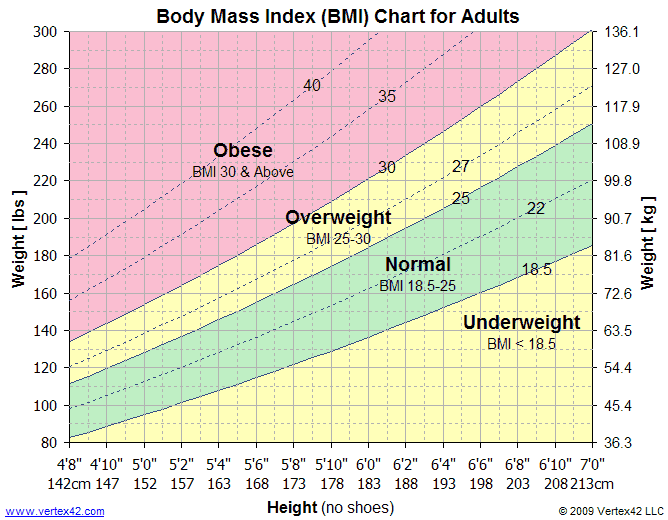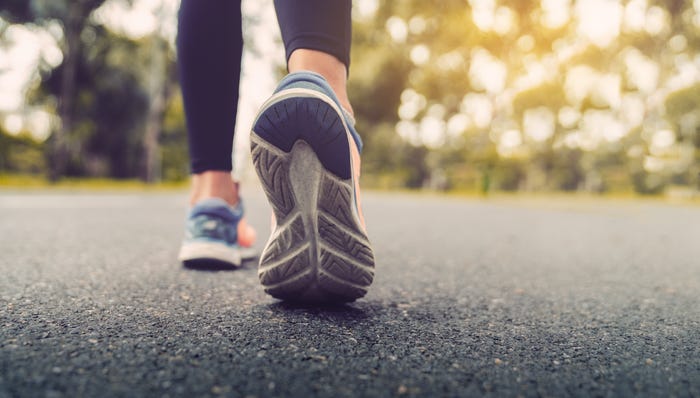The Benefits of Walking for Health
According to Mayo Clinic, consistent brisk walks can help maintain a healthy weight and lose body fat. A healthy weight can be determined by BMI, with the goal of having a BMI between 18.5-25. The chart below offers a general guide to determining one’s BMI.

In addition, consistent brisk walks can prevent various conditions such as heart disease, stroke, high blood pressure, cancer, and type 2 diabetes. Cardiovascular fitness, bones and muscles, energy, mood, immune system, stress, and tension can also be improved by regular brisk walks. Moreover, research shows that walking can improve mood by modifying your nervous system so you experience a decrease in negative emotions, which can make you feel happier. Research suggests that walking at a speed of around 3.5 mph, or more according to your capabilities, and up to 4 miles can have great health benefits. A study done in Brazil has shown that self-selected walking intensity was sufficient for participants in a normal weight group. This same assumption cannot be applied to those in other weight groups, thus talking to a doctor is important in determining what walking speed and intensity is adequate for you. Although it can be hard to track your pace during walks without a fitness app, it can be suggested to keep as fast of a pace as you can without elevating the heart rate beyond comfort. More importantly, it is crucial to consult your physician when started a new fitness routine to ensure safety.
The Technique
However, turning your normal walks into beneficial fitness activities requires the maintenance of good posture and movements. To ensure this, it is recommended that you keep your head up, look forwards and not to the ground, relax your neck, shoulders, and back, swing your arms freely with a slight bend in your elbows, and keep your stomach muscles engaged with your back straight, not arched backward or forwards.
In the following video, a physical therapist breaks down the motions of proper walking techniques in further detail and provides a demonstration. https://www.youtube.com/watch?v=-fD2TSL2s7I&ab_channel=RehabandRevive
Creating a Routine
Once proper technique is established to gain the most benefits out of your walks, creating a routine is vital in ensuring maximum benefits are reaped from this activity. Choosing the right walking shoes with a proper arch, study heels, and thick soles is important. When walking outdoors it is important to keep your path in mind, avoiding potholes, cracks, or uneven surfaces. Gently stretching after you cool down from a walk can also be beneficial and a part of your walking routine. The following blog discusses helpful stretches to perform after a walk.
Maintaining Goals
To make sure you follow through with your fitness goals and walking routine, it is important to maintain realistic goals as you progress forwards. Establishing these goals requires assessing your own ability and fitness capabilities, making sure to slowly progress, and prevent straining your body. For most people, walking around 10,000-15,000 steps a day is recommended. For beginners, this may be starting with brisk walks with a speed of 3-3.5 mph beginning with 10 minutes every day for a couple of weeks. Beginners can then increase their walking time by 5 minutes per week until they are able to walk for 30 minutes every day of the week. People at an intermediate level, or those already in good shape, can increase their speed to 3.5-4.5 mph and walk 3 miles 3-5 times a week. If walking at faster speeds is tough, walking a longer distance can make up for this. People at an advanced level can intensify their walking routines by adding weights or inclines to their route. It is important to talk to your doctor with any concerns before beginning a new walking routine. In some cases, starting a new fitness routine may require medical clearance from your physician.
Establishing a goal of walking during your lunch break or setting specific times of the day for walks are just some examples of realistic goals to maintain.
By establishing proper technique, routine, and goals for walking for fitness, one can prevent various health conditions and possibility lose body fat to maintain a healthy weight. Walking can be simply incorporated into your lifestyle in order to ensure health and wellness inside and out.
© Jasleen Ghai, 2021 | Pre-med student intern at SanMateoPrimaryCare.com and ApolloHCC.com
